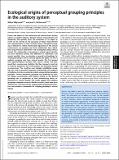Ecological origins of perceptual grouping principles in the auditory system
Author(s)
Młynarski, Wiktor; McDermott, Josh H
DownloadPublished version (1.382Mb)
Publisher Policy
Publisher Policy
Article is made available in accordance with the publisher's policy and may be subject to US copyright law. Please refer to the publisher's site for terms of use.
Terms of use
Metadata
Show full item recordAbstract
© 2019 National Academy of Sciences. All rights reserved. Events and objects in the world must be inferred from sensory signals to support behavior. Because sensory measurements are temporally and spatially local, the estimation of an object or event can be viewed as the grouping of these measurements into representations of their common causes. Perceptual grouping is believed to reflect internalized regularities of the natural environment, yet grouping cues have traditionally been identified using informal observation and investigated using artificial stimuli. The relationship of grouping to natural signal statistics has thus remained unclear, and additional or alternative cues remain possible. Here, we develop a general methodology for relating grouping to natural sensory signals and apply it to derive auditory grouping cues from natural sounds. We first learned local spectrotemporal features from natural sounds and measured their co-occurrence statistics. We then learned a small set of stimulus properties that could predict the measured feature co-occurrences. The resulting cues included established grouping cues, such as harmonic frequency relationships and temporal coincidence, but also revealed previously unappreciated grouping principles. Human perceptual grouping was predicted by natural feature co-occurrence, with humans relying on the derived grouping cues in proportion to their informativity about cooccurrence in natural sounds. The results suggest that auditory grouping is adapted to natural stimulus statistics, show how these statistics can reveal previously unappreciated grouping phenomena, and provide a framework for studying grouping in natural signals.
Date issued
2019Department
Massachusetts Institute of Technology. Department of Brain and Cognitive Sciences; Center for Brains, Minds, and Machines; McGovern Institute for Brain Research at MITJournal
Proceedings of the National Academy of Sciences of the United States of America
Publisher
Proceedings of the National Academy of Sciences